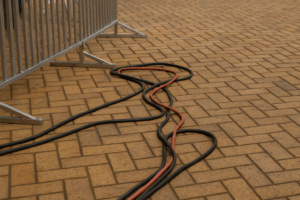
Arizona is investing heavily in its roads, with the Arizona Transportation Institute (AZTI) leading $11.5 million in projects aimed at making highways stronger, safer, and more durable. Researchers from Arizona State University, the University of Arizona, and Northern Arizona University are working with the Arizona Department of Transportation (ADOT) and federal agencies on everything from asphalt mixes that reduce costly repairs to strategies that protect roadways from wildfire damage.
But while these efforts promise smoother drives for motorists, sidewalks in certain Arizona communities tell a different story. Cracked pavement, broken slabs, and uneven surfaces remain common hazards for pedestrians, causing injuries that range from sprains to life-altering fractures.
Arizona law does give injured pedestrians ways to seek compensation, but the challenge is determining who should be held responsible for sidewalk maintenance. In this article, we’ll explain how liability works, who may be accountable, and the steps you can take if you’ve been injured on a broken sidewalk in Arizona.
Sidewalk maintenance responsibilities vary across Arizona communities. The obligation to maintain safe walkways might fall on a government entity, private property owner, or both parties, depending on the specific location. Understanding these divisions of responsibility is fundamental to pursuing your legal options.
Public sidewalks along city streets typically fall under local government jurisdiction. Arizona municipalities generally must maintain these walkways in reasonably safe condition for pedestrian use.
However, pursuing claims against government entities presents unique challenges.
Arizona’s sovereign immunity doctrine shields many government bodies from lawsuits unless the state has specifically waived immunity for particular types of claims. Cities can often be held liable for dangerous sidewalk conditions, but counties frequently enjoy broader immunity protections.
Arizona law also imposes strict procedural requirements for government claims. Under A.R.S. § 12-821.01, you must provide written notice to the government entity within 180 days of the incident. This notice must include specific details about the accident, injuries, and damages.
Missing this deadline typically destroys your ability to pursue compensation, even with a strong case.
Sidewalks on private property fall under different rules entirely. Shopping centers, apartment buildings, office complexes, and other private developments must maintain their walkways according to premises liability standards.
Arizona Revised Statutes § 12-681 establishes that property owners have a duty to maintain their premises in reasonably safe condition for lawful visitors. When a sidewalk on private property contains dangerous defects, and the owner knew or should have reasonably known about the hazard but failed to address it, they may face liability for resulting injuries.
Success in these cases often depends on proving both the dangerous condition and the owner’s actual or constructive knowledge of it. Documentation like maintenance records, complaint histories, or evidence of long-standing damage can demonstrate that the hazard wasn’t sudden or unforeseeable.
Some Arizona communities divide sidewalk duties between government entities and adjacent property owners through local ordinances. A city might handle major structural repairs while requiring property owners to remove debris, vegetation, or ice.
These shared arrangements complicate liability determinations, since both the municipality and property owner might bear partial responsibility for maintaining pedestrian safety.
Choosing the correct defendant in a sidewalk injury lawsuit affects far more than paperwork. The type of responsible party determines which legal procedures apply, what defenses you’ll encounter, and the potential value of your claim.
Lawsuits against Arizona cities involve more complex procedures than those against private parties. Beyond immunity protections that might block lawsuits entirely, injured pedestrians must navigate strict procedural requirements.
The 180-day notice requirement for government claims is particularly unforgiving. This deadline demands prompt action and specific information about the incident, injuries, and damages. Courts rarely excuse late notices, regardless of case strength.
Arizona also caps damages in certain government liability cases. These statutory limits can reduce available compensation below what would otherwise be recoverable, making thorough case evaluation critical before proceeding.
Claims against private property owners proceed under Arizona’s general premises liability framework, which focuses on whether the owner maintained reasonably safe conditions for visitors. While these cases still require proof of the hazardous condition and the owner’s knowledge, they avoid many procedural barriers that complicate government lawsuits.
Property owners commonly defend these cases by arguing the hazard was “open and obvious” or claiming the injured person contributed to their own harm through carelessness. Arizona follows comparative negligence principles under A.R.S. § 12-2505, so any shared fault reduces damage awards proportionally.
Arizona courts require clear evidence that the walkway’s condition created unreasonable danger and that the responsible party failed to address it properly.
Start by establishing that the sidewalk defect directly caused your injury. Courts examine whether the hazard posed genuine danger to ordinary pedestrians exercising reasonable care. Photographs of the defect, witness statements, incident reports, and evidence of prior problems all strengthen this foundation.
Next, identify who had the legal duty to maintain that particular sidewalk section. This determination shapes your entire legal strategy, since government entities and private property owners operate under different liability standards and procedural requirements.
Strong cases combine clear causation evidence with definitive responsibility allocation. Without both elements, even severe injuries might not meet Arizona’s legal standards for compensation.
Arizona’s statute of limitations gives injured pedestrians two years from the accident date to file lawsuits against private property owners under A.R.S. § 12-542. Government claims face much tighter deadlines, requiring written notice within just 180 days to preserve your right to sue.
Missing these deadlines or pursuing the wrong defendant can terminate your case before trial. Consulting with an Arizona personal injury attorney immediately after your accident provides the best protection for your legal rights. A lawyer can investigate the accident location, identify the correct defendants, and gather evidence needed to prove liability.
If you suffered injuries from a broken or unsafe sidewalk, don’t let time run out on your claim. Contact our experienced Arizona sidewalk injury attorneys today at Thompson Law for a FREE CONSULTATION to discuss your case. We cover all areas of California, Arizona, Georgia, and Texas.






Thompson Law charges NO FEE unless we obtain a settlement for your case. We’ve put over $1.9 billion in cash settlements in our clients’ pockets. Contact us today for a free, no-obligation consultation to discuss your accident, get your questions answered, and understand your legal options.
State law limits the time you have to file a claim after an injury accident, so call today.